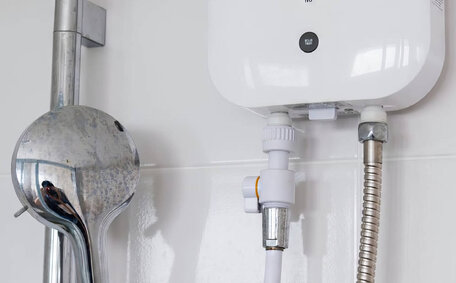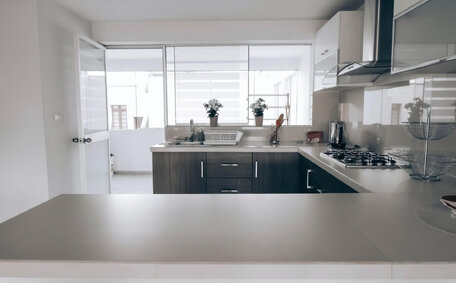Signs of a Blocked Drain
Several signs of a blocked drain include slow water drainage and unusual noises that could indicate a problem:
- Slow drainage in showers, sinks, or tubs often signifies a blockage
- Gurgling sounds emanating from drains
- Unpleasant odours that linger around your house, often emanating from drains
- Water pooling around floor drains signifies a blocked drain
- Toilets that back up or overflow
These issues typically signal a disruption in your drainage system, impeding wastewater flow. Blockages in your sewer line can lead to water backing up and can allow sewer gases to enter your home, potentially affecting your hot water systems. Prompt action to clear blocked drains is essential to prevent further damage, more serious blockages, and potential health risks.
Prevent minor obstructions from becoming major issues by installing drain screens, monitoring drain usage, avoiding misuse, and scheduling regular professional cleanings.
Locating the Drain Blockage
As a general rule, there are a few methods to help identify the specific location of a drain blockage:
- Listen for gurgling noises emanating down the sink - As you run water into the drains your home has, listen closely for gurgles or 'glugging’ sounds. These sounds can indicate an obstruction that may soon cause blockage in your pipes with water backing up behind a clog downstream.
- Check water flow at drains - Does water drain slower in some locations? This might be a clue to get your blocked sewer drain checked if it exists further into your pipeline.
- Use a plumber’s snake - Insert a flexible drain snake into sinks/toilets. Mark the depth when you meet resistance to estimate the clog’s location.
- Flush dyed water - Add harmless dye to water and let the water pour into various drains. Check where coloured water surfaces to pinpoint the area of backup.
Identifying common causes blocked for blockage locations down the line, like problems your sewer line faces, often requires specialised drain camera equipment. Trusted DIY methods can identify clogged rooms or pipe sections, information that is useful when consulting plumbing experts to expedite repairs.
It’s crucial to find blockage locations since infiltrating tree roots, one of the causes blocked drains, can rapidly spread and can cause piping damage if not promptly cleared.
DIY Drain Inspection Methods
Before calling a professional, homeowners can use several DIY methods to unblock drain issues and locate obstructions:
Boiling Water
Pouring hot water down your sinks and drains, serving as a natural solution, can dissolve minor clogs and flush away residue. This proactive approach aids in ensuring that drains can function normally, allowing you to assess water drainage speeds and identify problem areas.
- Boil water and let it cool for a minute before carefully pouring down the sink to soften potential blockages.
- Allow the water pour down slowly for clearing blocked sections of your drain to avoid splash back.
- Carry out the process 2-3 times, allowing a few days to evaluate if the water flow has improved between attempts.
- Especially avoid usage on drains with too much toilet paper, as a blocked drain can worsen completely blocked or closed-up drains.
Plunger
You can apply home remedies such as using a plunger on your sink drain and toilets with cold water to apply direct pressure on trapped debris or obstructions near the drain openings.
- Ensure your kitchen sink or basin is filled with water before submerging the plunger head to tackle obstructions.
- Work vigorously up and down with a tight seal for 15 seconds to dislodge any foreign objects.
- Repeat the process until the blockage is dislodged.
Baking Soda and Vinegar Treatment
Baking soda and vinegar can break down organic buildup in pipes effectively. The chemical reaction produces CO2 bubbles that can form and exert pressure, significantly aiding in breaking down and dislodging gunk.
- Disperse one cup of baking soda into the drain pipe, being mindful not to pour excessively, which can conversely exacerbate tough clogs.
- Then add 1 cup heated white vinegar, and quickly seal the drain.
- Allow the mixture to react for 5-10 minutes before rinsing it, ensuring that any remaining buildup is flushed away with hot water.
Use a drain cover afterwards to prevent food scraps from building up, which can easily lead to your drain becoming blocked.
Drain Augers/Snakes
Manually feed a hooked drain auger down pipes to hook blockages and extract hair soap scum, and debris.
- Ease the drain auger, inserted into the pipe, and hook one piece of debris at a time, gently turning the handle upon meeting resistance.
- Remove debris off auger hook before carefully retracting.
- Always use drain gloves or protective equipment to avoid contact with dirty water.
These DIY methods can clear minor obstructions, but utilising a professional plumbing service safeguards your sewage system. But for deep pipe issues, don’t hesitate to contact your local professional plumber who can inspect with specialised drain inspection equipment to locate severe blockages.
Professional Drain Inspections
For blocked drainage issues, rely on our guide where our professional inspectors have specialised tools designed to thoroughly evaluate your pipes:
Drain Cameras
High-resolution CCTV drain cameras feature a flexible cable with a camera on one end, allowing for thorough footage of pipe interiors. This technology reveals the condition of drain interiors, pinpointing exact blockage locations, which is especially valuable for diagnosing issues in older, vulnerable pipes.
Hydro-Jetting
Hydro-jetting uses high-pressure water streams to scrub pipe walls and dislodge accumulated residue. This deep cleaning opens blockages without damaging your pipe, tackling fats oils and other build-ups in the process.
Our guide to combining camera exams with targeted hydro-jet clearing gives professionals an in-depth view to develop customised solutions. A professional drain inspection provides peace of mind that issues have been accurately identified for permanent repairs.
Consider following our guide to address drain issues to avoid costly repairs, by hiring a professional plumber for:
- Complete clogs not cleared by DIY methods on your property
- Foul sewage odours indicating sewer gas leaks
- Backed up water, which is among the causes blocked drains, suggesting main line blocks
- Multiple or recurring clogs are drains common issues, often caused by invasive root damage or pipe deterioration
Addressing these substantial issues sometimes involves procedures like pipe relining, which requires advanced equipment and expertise to ensure lasting solutions.
Clearing Minor Blockages
Homeowners can utilise tried-and-true techniques, using your preferred methods, to ponder the best approach to unblock your drains:
A rubber plunger can effectively dislodge near-surface blockages with targeted pressure. Position it over the drain, fill the basin with water, then plunge vigorously to maintain a tight seal.
A mixture of baking soda and hot water can help clear drains of toilet paper, grease, soap scum, and light debris, maintaining hot water system efficiency. Allow the boiled water to cool for a minute before pouring slowly down the drain.
Baking Soda and Vinegar
Mix one cup of baking soda with one cup of heated white vinegar for a chemical reaction. The fizzing releases gas bubbles that might be causing blockage, helping to dislodge gunk, reducing the blockage your drains may be suffering from. Pour down drain then quickly seal for 5-10 minutes before rinsing.
Avoid caustic cleaners which can damage your pipes and contaminate waterways, and ensure you opt for safer alternatives. For severe or recurring blockages, your plumber has specialised augers and high-pressure jetting equipment to clear blocked drain effectively while inspecting pipes for issues like cracks or root invasion.
Removing Difficult Clogs
Removing stubborn drain clogs often requires more advanced DIY methods before calling a professional:
Hand Auger/Drain Snake
When confronting a clog, questioning 'How do I rectify a blocked drain?' might guide you towards strategies that could resolve the issue. Slowly feed the auger down the drain, asking yourself 'How do I tackle this?', then turn the handle upon resistance to resolve the issues your drains encounter. Remove any debris before slowly retracting.
- Wearing gloves can also offer protection.
- Don’t use excessive force or over-crank handles.
- Avoid scratching pipes with the snake’s tip when pulling back.
Powered Augers
Electric drill-powered drain snakes provide more torque and force for clearing longer pipes. Feed the spinning auger head down the drain in short increments, reversing direction when needed to snag stubborn clogs.
- Keep your safety cord plugged into a GFCI outlet.
- Keep fingers clear of the rotating auger.
Accessing Drainage Pipe Cleanouts
Remove the cleanout plug to clean out tough obstructions directly in drainage pipes with augers. This avoids scratching fixtures.
- Use a pipe wrench to loosen the threaded plug to ensure your drains stay in prime condition.
- Position a bucket beneath the work area to catch any backed-up water, ensuring the job is carried out cleanly without the risk of overflow.
- Insert the auger then replace the cleanout plug after.
Attempting to auger main sewer outside drain lines when signs blocked are present is dangerous due to unpredictable back pressure, so it’s best to call plumber. Call a professional instead who can hydro jet your sewer lines without pipe damage.
For deep clogs, try using heavy duty powered augers, reaching over 100 feet, and specialised water jetting equipment to scour virtually any blockage without scratching pipes. We evaluate issues like tree root invasion or pipe deterioration to implement permanent solutions.






